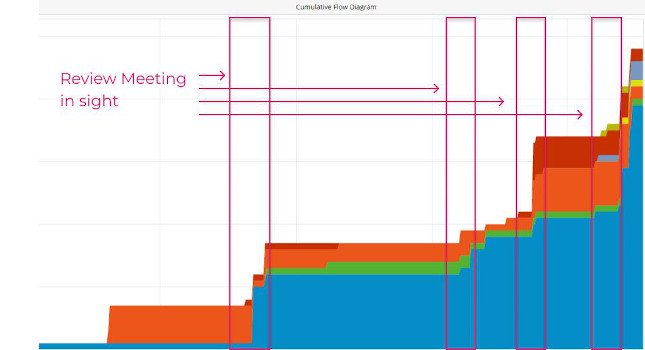Software brings Kanban methods to project management

The pigments and coatings industry is a regulation-heavy sector, defined by long innovation cycles and multiple development and testing stages before products are approved for commercial use. As shorter iterations and frequent experimentation can be costly, use of waterfall models and phase gate processes represent the traditional approach to projects in this field.
Schlenk is a leading manufacturer of metal powders, pigments, and foils. It focuses on markets for metal foils, coatings & plastics, printing & graphics, building materials & chemicals and other materials industries.
Figure 2: Team boards broke down work in each project. Courtesy: Kanbanize[/caption]
It also required extensive planning of milestones and deadlines for project stages, but often lacked up-to-date information on project status or performance. This limited the ability to optimize the work process and improve efficiency over time.
Searching for project efficiencies
Forming a new team, Schlenk’s management explored alternative methods for the management of innovation projects. The goal was to get past the shortcomings of the traditional approach and to gain a competitive advantage.
Looking for ways to improve the cross-team coordination, increase project transparency, and unlock optimization potentials, they came upon the Kanban method. Schlenk identified it as an effective way to connect all project stakeholders and create an efficient workflow in their future projects.
Schlenk started by applying core principles and practices. They decided to skip the set-up of physical boards and work with digital boards from the start, so updates on project work and progress will be accessible from everywhere.
Using Kanban boards, Schlenk was able to reach a new level of transparency that allowed everyone to easily check what is in progress, who’s work depends on it and what comes next in the pipeline. Visualizing the workflow and all items processed uncovers process blockers and dependencies, for better understanding of the relevance of different tasks.
Looking at Kanban metrics such as cycle time, throughput and flow efficiency to evaluate the performance of a project or a team provided Schlenk with in-depth insights into its work processes. It also revealed when teams or projects were slowing down. That way, they aren’t merely checking if deadlines are met, but a continuous flow of work.
With actionable metrics and favoring incremental, evolutionary change, Kanban also opened the door for continuous process improvements.
Choosing Kanban as their tool for project management, Schlenk’s next step was to decide what Kanban-based project management software best matched their needs. After evaluating several professional Kanban tools on the market as to ease of implementation, level of workflow transparency created, and responsiveness of the provider they moved forward with Kanbanize.
End-to-end project flow
Being able to structure work in several hierarchical levels through the parent-child card linking option, Schlenk introduced Flight Levels to manage research projects. It could visualize the end-to-end flow of project work and interlinked the work from different project management levels and from various departments in one place.
Figure 4: Block-card function. Courtesy: Kanbanize[/caption]
Through the Fight-Level structure and the linking of work items, Schlenk’s Portfolio board became an automated real-time status report. This allowed a more probabilistic agile approach to planning and provided that big picture, without losing sight of details (See Figure 3).
With more than one team contributing to one project, optimizing the workflow beyond the team border was essential for improving the project performance. Through the described work breakdown and linking structure, Schlenk connected the work of different departments into one project flow and unlocked optimization potential on the coordination level, by improving cross-departmental synchronization and removing process bottlenecks.
With everyone using Kanbanize, different departments had a direct link between each other, and all project stakeholders had the full picture in front of their eyes. A particular benefit of the shared work environment was noted in the improved coordination between the Research and Analytics departments.
While previously, the Chemistry team had to ask and wait for a status update from their coworkers on how the processing of lab results was going, now Kanbanize automatically visualized any updates. When work items were ready for the next work stage, everyone immediately saw it, reducing waiting times and supporting a stable workflow on and above the team level.
Another feature that helped Schlenk optimize the workflow beyond the team border was the “block card” function. It allowed team members to visually signal to everyone that their workflow had stopped. (See Figure 4)
Gain visibility across projects
In Kanbanize, if one child card on the Team board is blocked, this is visualized on the parent initiative and on the dashboard of the workspace. This allows managers to quickly spot where the project progress is hindered and to identify urgent matters.
Figure 6: Optimization steps. Courtesy: Kanbanize[/caption]
Despite structuring deliverables in larger batches, due to the nature of work in the chemical industry, applying Kanban techniques and metrics helped SCHLENK’s teams achieve a smoother workflow.
Another process optimization that led to shorter cycle times and improved project performance was the introduction of WIP limits.
Limiting the number of task items that a team is currently working on is a key practice for Kanban. In one case, it helped Schlenk to reduce the cycle time of one team from 110 days to 44 days (at the 85% percentile). Allowing fewer tasks to enter the system simultaneously speeded up their execution and led to an increase in the throughput (See Figure 7).
How the teams use it
With the analytics module in their hands, teams also used the data to gain a better overview of performance. The ability to extract information on how much time they spend on different task types allowed the Analytical department to use Kanbanize when reporting to upper management. The need for data collection and time spent preparing documents is reduced.
Focusing on cycle time, throughput and flow led to continuous improvement efforts. Work processes became more efficient over time. Tasks were processed quicker, more work items exited the system and a stable work process on a project level was achieved, resulting in an overall improvement of the project performance (See Figure 8).
A few months after the initial introduction of the tool, Schlenk sent a survey to its users, asking for feedback. Some of the benefits of Kanban and Kanbanize they named were:
- Excellent overview of workload
- Easy top-down synchronization of priorities
- Just in time information
- Just in time recognition of bottlenecks
- Excellent idea management (backlog)
- Optimization of workflow
- Easy transfer of work between part time workers.
Respondents said they were able to visualize work. Kanbanize gave them an overview of their colleagues’ tasks, so they felt more informed about work items that they depended on.
Associates even encouraged others to use Kanbanize more actively. Even better, users said that, compared to other tools, where benefits seem to be only for the management, here every user recognized benefits in their work. This led to high acceptance and wide usage of the tool.
Seeing the benefits Kanbanize brings for their teams, Schlenk went a step further and invited a supplier to collaborate on their Kanban boards. By integrating the external company in their workflow, they managed to improve the coordination and communication and to streamline the exchange of relevant information.
Next, Schlenk plans to further expand the use of the tool and to also invite a customer to collaborate in their workflow.



